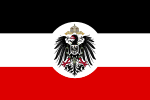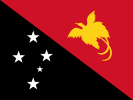Flag of Papua New Guinea
This article needs additional citations for verification. (September 2015) |
| Proportion | 3:4 |
|---|---|
| Adopted | 1 July 1971 |
| Design | Divided diagonally from the upper hoist-side corner to the lower fly-side corner: the upper triangle is red with the soaring Raggiana bird-of-paradise and the lower triangle is black with the Southern Cross of four white larger five-pointed stars and the smaller star. |
| Designed by | Susan Karike Huhume |
 | |
| Use | Naval ensign |
| Proportion | 3:4 |
| Design | A white flag with the national flag of Papua New Guinea in the canton |

The flag of
Red and black have long been traditional colours of many Papua New Guinean tribes. Black-white-red was the colour of the German Empire flag, which had colonised New Guinea prior to 1918. The bird-of-paradise is also found on the national coat-of-arms. The Southern Cross shows that it is a country in the Southern Hemisphere and can be seen in Papua New Guinea.[citation needed]
Prior to independence, the Australian administration proposed a vertical tricolour flag with blue, yellow and green bands, along with the bird of paradise and southern cross, designed by Hal Holman.[2] The blue was said to represent the sea and islands of New Guinea, the Southern Cross was a guide for the traveling peoples, the gold represented the coastlines, mineral wealth, and unity, and the green represented the forested highlands and mainland, with the Bird of Paradise representing the unification under one nation.[3] It had a mainly negative reception, due to its appearance as that of a "mechanically contrived outcome", thus an alternate version attributed to 15-year old schoolgirl Susan Karike was chosen instead.[4]
Government flags
Historical flags of Papua New Guinea
-
 Proposed flag of German New Guinea in 1914, but never implemented
Proposed flag of German New Guinea in 1914, but never implemented -
 Flag of the Territory of Papua, 1906–1949
Flag of the Territory of Papua, 1906–1949 -
 Flag of the Territory of New Guinea, 1914–1949
Flag of the Territory of New Guinea, 1914–1949 -
 Flag used by Territory of Papua and New Guinea at sports events, 1965–1970
Flag used by Territory of Papua and New Guinea at sports events, 1965–1970 -
 Proposed flag for Territory of Papua and New Guinea, 1970–1971
Proposed flag for Territory of Papua and New Guinea, 1970–1971 -
Flag of the Territory of Papua and New Guinea, 1971–1975, and of Papua New Guinea, 1975–present
See also
References
- ^ www.pngbd.com
- ^ Littler, Geoff. "The Papua New Guinea Crest and Flag". PNGAA. Retrieved February 20, 2016.
- ^ "Papua and New Guinea 1970–1971 (Australia) Australian Trust Territory of Papua and New Guinea". FOTW Flags of the World. Retrieved February 20, 2016.
- ^ "The true inside story of the saga of the PNG flag".










